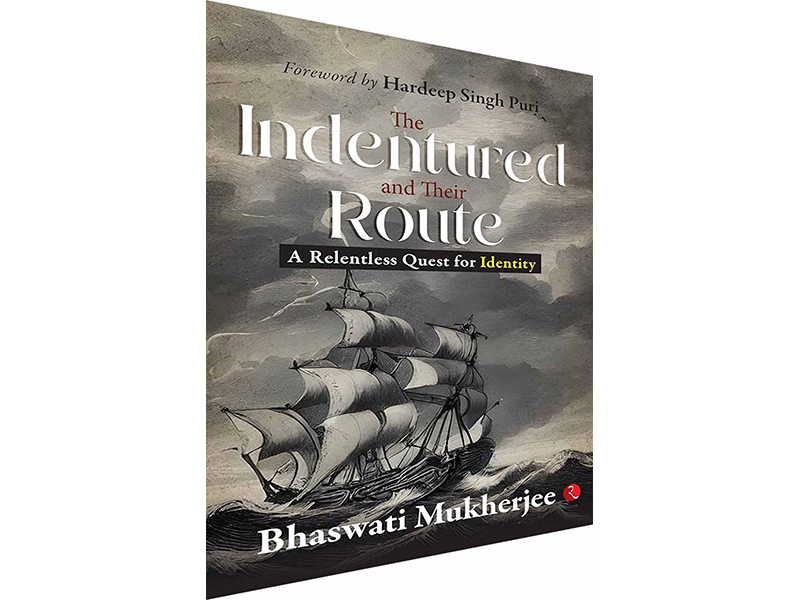Slavery by other name
 The Indentured and Their Route: A Relentless Quest for Identity
The Indentured and Their Route: A Relentless Quest for Identity
Bhaswati Mukherjee
Rupa Publications
Rs.595
Pages 214
As soon as slavery was outlawed in all territories of the British empire in 1834, the practice of indenturing labour from India began
This is a book which chronicles the use, by indenturing, of 1.3 million impoverished labourers from eastern and southern India for cultivation in the British-owned plantations in West Indies, Fiji and Mauritius. It tells a grim tale of inhumane conditions, both in the voyage to far flung plantations as well as the torturous conditions of work they had to endure in alien situations. As analysed by other scholars, the book refers to the link between the legislation which ended slavery in British territories by 1808 as well as the end of ‘apprenticeship’ by former slaves in British-owned plantations in 1834, and the indenturing of labour, primarily from India, starting in 1834 itself. The arrangement implied the need to find labour to work in near servitude conditions so not to interrupt cultivation in plantations owned by British financiers.
A diplomat by profession, Bhaswati Mukherjee wears the robe of a meticulous historian in drafting the contents of this slim book. She highlights three specific aspects of her proposed analysis in its blurb. They include: (a) differential between indentured status and slavery (or coolitude) of workers; (b) a need to discover the route (or journey) of the indentured, and (c) the search for identity serving as saviour for the indentured, flourishing over time as diaspora.
Mukherjee further comments, in the preface which follows, on the forgotten indentured route, contrasting the slave route which was brought to light by Unesco and African states in 2014. However, the author contradicts herself with her citations of available literature which abound, very appropriately, in her scholarly book.
Before proceeding further, she highlights how unfair the practice of indenturing turned out, with ‘so-called’ written contracts (girmit) and migration to undisclosed destinations, was different in form (but not content) to slavery.
Only one-fifth of the 1.3 million recruited between 1838 and 1917 (when the system ended) returned to India. Thus the perilous conditions of the journey which took a toll on 80 percent of the recruits continued, despite the promise agreed upon in their contract (or girmit) of providing return fare! The reasons are documented in the following chapters.
The deceit implicit in the so-called girmit was the promise of a better life and safe return home on completion of work over a minimum period. The causes of migration were that impoverished labourers in India’s countryside faced severe famine (mostly man-made), commercialisation of agriculture and huge transfers of financial resources to meet Britain’s overseas expenses (titled as ‘home charges’) — all of which resulted from policies which suited Great Britain. These conditions made it easy for recruiters (arkatiy) to entice and trap the poor for the undisclosed voyage. Incidentally, payments to recruiters by higher officials were made on the basis of the number recruited.
Those lured (or even blackmailed or kidnapped) to join, faced a rough journey under bleak conditions, which often led to death. However, from the British perspective, the offer of indenture was a relief, the prospect of a better life for the famine-stricken poor of the subcontinent.
In the chapters following, the author recounts in graphic detail the deceitful girmit innovated by overseas planters with the connivance of Raj officials when slavery ended in the British Empire, and the hazardous journey of the indentured.
Other incisive details of the exploitative girmit system are described in progressive chapters. The thumb-print substituting for signatures of completely illiterate labourers for providing the girmit was treated technically “…as a legal contract between equal partners”, one more instance of fraudulent administration by the British rulers of India. One can add that this was in accord with the well-designed expropriation of surpluses from subordinated colonies like India.
Information on the journey, which often caused fatal infectious diseases such as cholera along with back-breaking manual work in the plantations, was gradually filtering out to the public in England as well as in India, prompting pressure to end the indenture system. The anti-slavery lobby in England and nationalist groups in India (led in particular by Pandit Madan Mohan Malaviya) forced the end of indenturing of Indian labour in 1917.
This history details the tortuous journey, across the kalapani (ocean) which for a large number of Indians was prohibited by caste or religion. The indentured had the least idea when putting their thumbprint on a contract that the journey would be across the kalapani. The shock included dietary fare which was completely alien compared to their regular meals. The ships were not initially prepared for the basic ingredients of a simple Indian meal. The crew or even doctors, if available, were often ‘contemptuous’ of desi meals. The consequences were starvation, indigestion and often fatal disease.
The author also highlights the role of plantation owners in London city in devising the scheme of indenture as a substitute for slavery. As pointed out in available literature on indenturing, financiers in the city were very active in allocating labour to estates they owned, in the supervision of bonded workers, and the trans-shipment of raw (brown) sugar to England to process it as white sugar for export to the rest of the world. It has often been pointed out by this reviewer that the pattern was of a triangular transfer, of indentured labour from India to plantations, then of raw sugar from plantations to Britain where it was processed into white sugar for overseas markets.
The book also includes a chapter on women who are usually forgotten, providing unpublished material which will be of much use for researchers. The last three chapters are an interesting account of the ‘diaspora’, those left behind at the end of the contracts. They focus on the rescue and revival of their language and culture as ‘saviour and redeemer’ of forgotten aspects of the life of the indentured in India.
The rise of the diaspora also gave power to nationalist struggles centred in the newly formed island-states and ended colonial rule therein. The role, in particular, of Mahatma Gandhi in South Africa is mentioned as a major force to contest apartheid and racism behind the vicious practice of indenturing.
Documentation, as provided by Mukherjee in this small volume makes it useful for further research by scholars. In addition, the author has made an effort to provide as many as 24 photographs of indentured labour, their work conditions, their families including single shots of women. I most value the plate printed as farcical employment contract on page 96 with the fingerprint of an unfortunate indentured on the girmitiya.
A useful supplement to available literature on indentured labour from India.
Sunanda Sen (The Book Review)
















Add comment